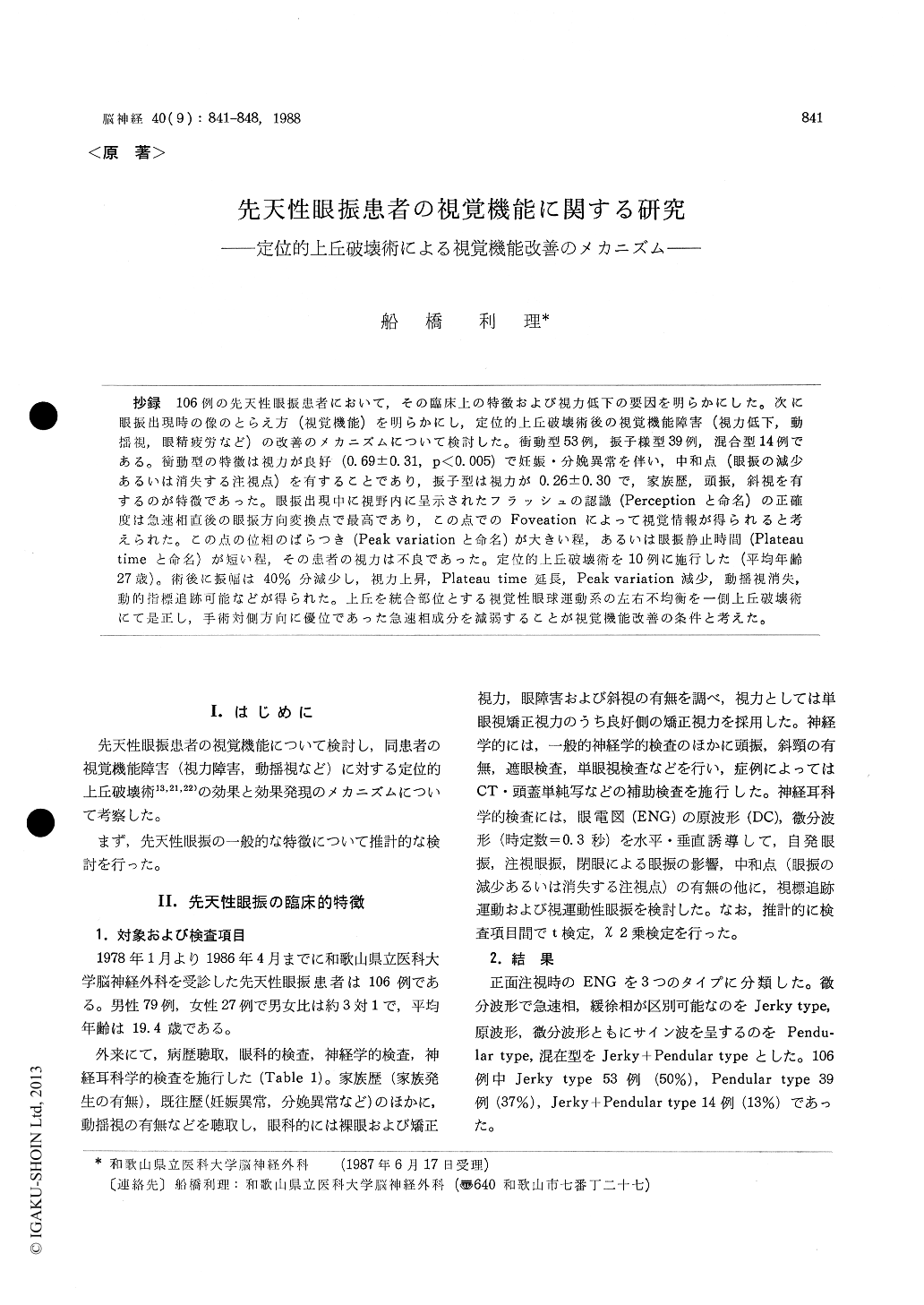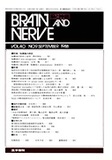Japanese
English
- 有料閲覧
- Abstract 文献概要
- 1ページ目 Look Inside
抄録 106例の先天性眼振患者において,その臨床上の特徴および視力低下の要因を明らかにした。次に眼振出現時の像のとらえ方(視覚機能)を明らかにし,定位的上丘破壊術後の視覚機能障害(視力低下,動揺視,眼精疲労など)の改善のメカニズムについて検討した。衝動型53例,振子様型39例,混合型14例である。衝動型の特徴は視力が良好(0.69±0.31,p<0.005)で妊娠・分娩異常を伴い,中和点(眼振の減少あるいは消失する注視点)を有することであり,振子型は視力が0.26±0.30で,家族歴,頭振,斜視を有するのが特徴であった。眼振出現中に視野内に呈示されたフラッシュの認識(Perceptionと命名)の正確度は急速相直後の眼振方向変換点で最高であり,この点でのFoveationによって視覚情報が得られると考えられた。この点の位相のばらつき(Peak variationと命名)が大きい程,あるいは眼振静止時間(Plateautimeと命名)が短い程,その患者の視力は不良であった。定位的上丘破壊術を10例に施行した(平均年齢27歳)。術後に振幅は40%分減少し,視力上昇,Plateau time延長,Peak variation減少,動揺視消失,動的指標追跡可能などが得られた。上丘を統合部位とする視覚性眼球運動系の左右不均衡を一側上丘破壊術にて是正し,手術対側方向に優位であった急速相成分を減弱することが視覚機能改善の条件と考えた。
The clinical features of congenital nystagmus (CN) were studied statistically in 106 cases of CN. The point of the nystagmus at which the patients could best see the targets was detected in somepatients. The effects of superior colliculotomy on their visual disturbance and the mechanism will be discussed. The study population comprises 106 patients, 79 males and 27 females, aged from one to 64 (mean 19.4 years).
Patients with jerky type classified on ENG were found in 53 cases (50%), pendular type in 39 cases (37%), and mixed type in 14 cases (13%). Patients with jerky type showed significantly good visual acuity (mean 0.69±0.31, p<0.005). They show-ed significant abnormalities during pregnancy and delivery (p<0.01) and had a neutral point (p<0.01). Patients with pendular type, on the other hand, showed poor visual acuity (mean 0.26 ±0.30) and had significant frequency of family history (p<0.05), head tremor (p<0.01) and strabismus (p<0.01). Thirteen cases (12%) had ocular diseases which involved the retina, cornea and optic nerve.
Visual function was elaborated on such parame-ters of ENG as perception, peak variation and plateau time. Perception, which means the ability to detect the dim flashes during the appearance of the nystagmus, was manifested by pushing a button when patients could detect flashes present-ed at random on the screen. At the turning point from the quick phase to the slow phase, the detection was executed most successfully. It is thought that in CN, a target is usually gazed upon at a point, changing the direction from the quick phase to the slow phase. Peak variation, named originally by the author as the variation of the visual angle from a base line to the peaks on ENG, showed a significant negative correlation with visual acuity. It suggests that peak variation means an accuracy of the foveation. Plateau time, also named originally as the interval during which the nystagmus is still at the peak, showed signifi-cant positive correlation with visual acuity. It sug-gests that plateau time means the duration of the foveation. Good visual acuity is expected in cases where peak variation has a small value and/or plateau time shows a large one.
Superior colliculotomy was performed in 10 cases ranging from 18 to 42 (mean 27.0 years), 8 of them were jerky and 2 pendular. Seven cases showed decrease of the amplitude by 40%. Two of them obtained the elevation of the visul acuity 0.2 and 0.3. Plateau time prologned in 2 of 4 cases after the operation. Nine cases showed the decrease of peak variation and obtained a decrease in the degree of oscillopsia.
The mechanism of the improvement in visual function after superior colliculotomy was thought that the reduction of the neural activity eliciting the quick phase of the nystagmus after the opera-tion contralateral to the quick phase induced the decrease of peak variation and prolongation of the plateau time. Then the patients could foveate thetargets more correctly and continuously at every lateral end of the quick phase.

Copyright © 1988, Igaku-Shoin Ltd. All rights reserved.


